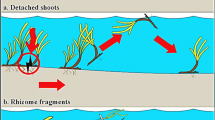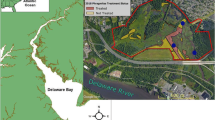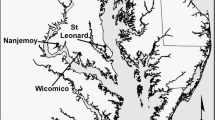Abstract
In aquatic habitats, both vegetative and sexual reproduction are involved in vegetation maintenance. Restoration projects carried out in such habitats rarely consider the role of both sexual reproduction (seeds) and vegetative (vegetative propagules or clonal fragments) components of propagule banks in vegetation regeneration. Moreover, changes in the seed bank due to the restoration itself have rarely been studied. The aim of this paper is to answer the following questions. Does restoration consisting of sediment removal in a cut-off meander lead to a change in the propagule bank (both sexual and vegetative propagules), and does the vegetation regeneration involve vegetative propagules created by plant breakage during the disturbance? Vegetation was visually surveyed three times during a 15-year period before the restoration and two years afterwards in both the restored zone and an upstream undisturbed zone. The propagule bank was characterized just before and one year after the restoration in the restored zone by sampling of sediment cores and propagule germination in a greenhouse. The impact of restoration on the propagule bank was very pronounced. Sprouting propagules were three times more abundant in post-restoration samples than in prerestoration samples. The ratio of seeds / vegetative propagules in the bank was lower in the year following restoration. Links between propagule bank and established vegetation were assessed through calculation of correlation and similarity indices. We observed a large difference between established vegetation and the propagule bank before restoration, suggesting that recruitment from the propagule bank was low before restoration. Restoration enhanced the recruitment from rhizomes and vegetative fragments, which were highly correlated with the established vegetation. the pre-eminent role of some vegetative propagules in the recolonization and the increasing abundance of an invasive species are related to the season (June) in which restoration was carried out. Impact of restoration on both the propagule bank composition and environmental conditions (especially those promoting or inhibiting germination or sprouting) thus has to be considered in further vegetation management work.
Similar content being viewed by others
Literature Cited
Abernethy, V. J. and N. J. Willby. 1999. Changes along a disturbance gradient in the density and composition of propagule banks in floodplain aquatic habitats. Plant Ecology 140:177–190.
Aiken, S. G., P. R. Newroth, and I. Wile. 1979. The biology of Canadian weeds 34: Myriophyllum spicatum L. Canadian Journal of Plant Science 59:201–215.
Amoros, C. and G. Bornette. 1999. Antagonistic and cumulative effects of connectivity: a predictive model based on aquatic vegetation in riverine wetlands. Archiv für Hydrobiogie Supplement 115/3:311–327.
Amoros, C., G. Bornette, and C. P. Henry. 2000. A vegetation-based method for ecological diagnosis of riverine wetlands. Environmental Management 25:211–227.
Baldwin, A. H. and E. Derico. 1999. The seed bank of a restored tidal freshwater marsh in Washington, DC. Urban Ecosystems 3: 5–20.
Bakker, J. P. and F. Berendse. 1999. Constraints in the restoration of ecological diversity in grassland and heathland communities. Trends in Ecology and Evolution 14:63–68.
Barrat-Segretain, M. H. 1996. Germination and colonisation dynamics of Nuphar lutea (L.) in a river channel. Aquatic Botany 55:31–38.
Barrat-Segretain, M. H. 2001. Invasive species in the Rhône River floodplain (France): replacement of Elodea canadensis Michaux by E. nuttallii St John in two fromer river channels. Archiv für Hydrobiologie 152:237–251.
Barrat-Segretain, M. H., G. Bornette, and A. Hering-Vilas-Bôas. 1998. Comparative abilities of vegetative regeneration among aquatic plants growing in disturbed habitats. Aquatic Botany 60:201–211.
Barrat-Segretain, M. H., C. Henry, and G. Bornette. 1999 Regeneration and colonisation of aquatic plant fragments in relation to the disturbance frequency of their habitats. Archiv für Hydrobiologie 145:111–127.
Belsky, A. J. 1986. Revegetation of artificial disturbances in grassland of the Serengeti National Park, Tanzania. II—five years of successional change. Journal of Ecology 74:937–951.
Bigwood, D. W. and D. W. Inouye. 1988. Spatial pattern analysis of seed banks: an improved method and optimized sampling. Ecology 69:497–507.
Bonis, A. and J. Lepart. 1994. Vertical structure of seed banks and the impact of depth of burial on recruitment in two temporary marshes. Vegetatio 112:127–139.
Bornette, G. and C. Amoros. 1991. Aquatic vegetation and hydrology of a braided river floodplain. Journal of Vegetation Science 2:497–512.
Bornette, G., C. Amoros, C. Castella, and J. L. beffy. 1994. Succession and fluctuation in the aquatic vegetation of two former Rhône River channels. Vegetatio 110:171–184.
Bornette, G., C. Amoros, and J.-C. Rostan. 1996. River incision and vegetation dynamics in cut-off channels. Aquatic Sciences 58:31–51.
Braun-Blanquet, J. 1932. Plant Sociology: the Study of Plant communities (Transl. G. D. Fuller and H. S. Conard). McGraw Hill Book Co., New York, NY, USA.
Chessel, D. and S. Dolédec. 1996. ADE version 4.0: Hypercard (©) Stacks and Quickbasic Microsoft (©) Programme Library for the Analysis of Environmental Data. Ecologie des eaux douces et des grands fleuves—ESA CNRS 5023, Université Lyon 1, France.
Citterio, A. and H. Piegay. 2000. L’atterrissement des bras morts de la basse vallée de l’Ain: dynamique recente et facteurs de contrôle. Geomorphologie: Relief, Processus, Environnement 2:87–104.
Collins, B. and G. Wein. 1995. Seed bank and vegetation of constructed reservoir. Wetlands 15:374–385.
Combroux, I. C., G. Bornette, N. J. Willby, and C. Amoros. 2001. Regenerative strategies of aquatic plants in disturbed habitats: the role of the propagule bank. Archiv für Hydrobiologie 152:215–235.
Denslow, J. S. 1980. Patterns of plant species diversity during succession under different disturbance regimes. Oecologia 46:18–21.
Dittmar, L. A. and R. K. Neely. 1999. Wetland seed bank response to sedimentation varying in loading rate and texture. Wetlands 192:341–351.
Dolédec, S. and D. Chessel. 1991. Recent developments in linear ordination methods for environmental sciences. Advances in Ecology 1:133–155.
Galatowitsch, S. M. and A. G. van der Valk. 1996. The vegetation of restored and natural prairie wetlands. Ecological Applications 6:102–112.
Grime, J. P. 1981. The role of seed dormancy in vegetation dynamics. Annals of Applied Biology 98:555–558.
Grime, J. P. and S. H. Hillier. 1992. The contribution of seedling regeneration to the structure and dynamics of plant communities and larger units of landscape. p. 349–364. In M. Fenner (ed.) Seeds—The Ecology of Regeneration in Plant Communities. CAB International, Wallingford, Oxon, UK.
Grime, J. P., J. G. Hodgson, and R. Hunt. 1988. The Comparative Plant Ecology, a Functional Approach to Common British Species. Unwin Hyman, London, UK.
Gross, K. L. 1990. A comparison of methods for estimating seed number in the soil. Journal of Ecology 78:1079–1093.
Heslop-Harrison, Y. 1955. Nuphar. Journal of Ecology 43:342–355.
Kadono, Y. 1984. Comparative ecology of Japanese Potamogeton: an extensive survey with special reference to growth form and life cycle. Japanese Journal of Ecology 34:161–172.
Kautsky, L. 1990. Seed and tuber banks of aquatic macrophytes in the Askö area, northern Baltic proper. Holarctic Ecology 13:143–148.
Klein, J. P. and R. Carbiener. 1989. Intérêt et application de la cartographie écologique á l’étude d’écosystèmes dulcaqucoles: l’exemple de deux rivières phréatiques, du champ d’inondation de l’Ill. Bulletin de l’Association Philomathique d’Alsace et de Lorraine 25:33–61.
Kotanen, P. M. 1996. Revegetation following soil disturbance in a California meadow: the role of propagule supply. Oecologia 108:652–662.
Lambinon, J., J.-E. De Langhe, L. Delvosalle, and J. Duvigneaud. 1992. Nouvelle Flore de la Belgique, du Grand-Duché de Luxembourg, du Nord de la France et des régions voisines (Ptéridophytes et Spermatophytes). Edition du Jardin botanique national de Belgique, Meise, Belgium.
Le Page, C. and P. A. Keddy 1998. Reserves of buried seeds in beaver ponds. Wetlands 18:242–247.
Lundholm, J. T. and W. L. Simser. 1999. Regeneration of submerged macrophyte populations in a disturbed Lake Ontario coastal marsh. Journal of Great Lakes Research 252:395–400.
McKnight, S. K. 1992. Transplanted seed bank response to draw-down time in a created wetland in east Texas. Wetlands 122:79–90.
Noble, I. R. and R. O. Slatyer. 1980. The use of vital attributes to predict successional changes in plant communities subject to recurrent disturbances. Vegetatio 43:5–21.
Piegay, H., G. Bornette, A. Citterio, E. Herouin, B. Moulin, and C. Statiotis. 2000. Channel instability as a control factor on silting dynamics and vegetation patterns within perifluvial aquatic zones. Hydrological Processes 14:3011–3029.
Raven, P. J. 1986. Changes of in-channel vegetation following two-stage channel construction on a small rural clay river. Journal of Applied Ecology 23:333–345.
Reed, D. C., P. T. Raimondi, M. H. Carr, and L. Goldwasser. 2000. The role of dispersal and disturbance in determining spatial heterogeneity in sedentary organisms. Ecology 81:2011–2026.
Roberts, H. A. 1981. Seed banks in the soil. Advances in Applied Biology 6:1–55.
Simpson, D. A. 1990. Displacement of Elodea canadensis Michx by Elodea nuttallii (Planch.) H. St. John in the British Isles. Watsonia 18:173–177.
Smith, L. M. and J. A. Kadlec. 1983. Seed banks and their role during drawdown of North American marsh. Journal of Applied Ecology 20:673–684.
Smits, A. J. M., P. H. van Avesaath, and G. van der Velde. 1990. Germination requirements and seed banks of some nymphaeid macrophytes: Nymphaea alba L., Nuphar lutea (L.) Sm. and Nymphoides peltata (Gmel.) O. Kuntze. Freshwater Biology 24:315–326.
Sørensen, T. A. 1948. A method of establishing groups of equal amplitude in plant sociology based on similarity of species content and its application to analyses of the vegetation on Danish commons. Det Kongelige Danske Videnskabernes Selskab—Biologiske Skrifter 5:1–34.
Sousa, W. P. 1984. The role of disturbance in natural communities. Annual Review of Ecology and Systematics 15:353–391.
Spencer, D. F. and G. G. Ksander. 1992. Influence of temperature and moisture on vegetative propagule germination of Potamogeton species: implications for aquatic plant management. Aquatic Botany 43:351–364.
Stylinski, C. D. and E. B. Allen. 1999. Lack of native species recovery following severe exotic disturbance in southern Californian shrublands. Journal of Applied Ecology 36:544–554.
ter Braak, C. J. F. 1995. Ordination. p. 91–173. In R.H.G. Jongman, C. J. F. ter Braak, and O. F. R. Van Tongeren (eds.) Data Analysis in Community and Landscape Ecology. Cambridge University Press, New York, NY, USA.
Thompson, K. and J. P. Grime. 1979. Seasonal variation in the seed banks of herbaceous species in ten contrasting habitats. Journal of Ecology 67:893–921.
van der valk, A. G. and R. L. Pederson. 1989. Seed banks and the management and restoration of natural vegetation. p. 329–363. In M. A. Leck, V. T. Parker, and R. L. Simpson (eds.) Ecology of Soil Seed Banks. Academic Press Inc., San Diego, CA, USA.
van der Valk, A. G., R. L. Pederson, and C. B. Davis. 1992. Restoration and creation of freshwater wetlands using seed banks. Wetlands Ecology and Management 14:191–197.
van der Valk, A. G. and J. T. A. Verhoeven. 1988. Potential role of seed banks and understorey vegetation in restoring quaking fens from floating forests. Vegetatio 76:3–13.
Vivian-Smith, G. and S. N. Handel. 1996. Freshwater wetland restoration of an abandoned sand mine: seed bank recruitment dynamics and plant colonisation. Wetlands 16:185–196.
Wade, P. M. 1993. The influence of vegetation pre-dredging on the post-dredging community. Journal of Aquatic Plant Management 31:141–144.
Welling, C. H., R. L. Pederson, and A. G. van der Valk. 1988. Temporal patterns in recruitment from the seed bank during drawdowns in a prairie wetland. Journal of Applied Ecology 25:999–1007.
Wetzel, P. R., A. G. van der Valk, and L. A. Toth. 2001. Restoration of wetland vegetation on the Kissimmee River floodplain: potential role of seed banks. Wetlands 21:189–198.
Author information
Authors and Affiliations
Corresponding author
Rights and permissions
About this article
Cite this article
Combroux, I.C.S., Bornette, G. & Amoros, C. Plant regenerative strategies after a major disturbance: The case of a riverine wetland restoration. Wetlands 22, 234–246 (2002). https://doi.org/10.1672/0277-5212(2002)022[0234:PRSAAM]2.0.CO;2
Received:
Revised:
Accepted:
Issue Date:
DOI: https://doi.org/10.1672/0277-5212(2002)022[0234:PRSAAM]2.0.CO;2




